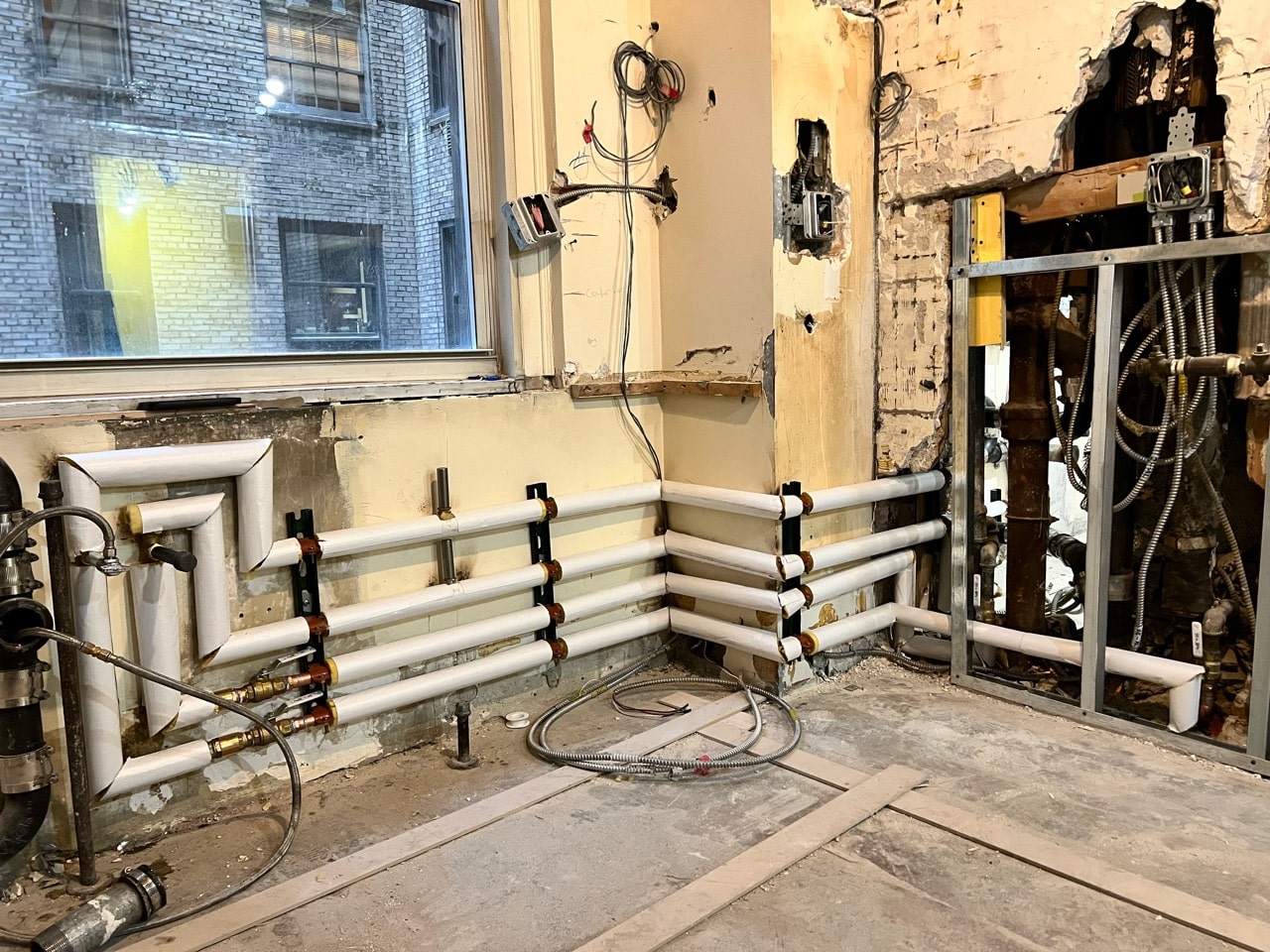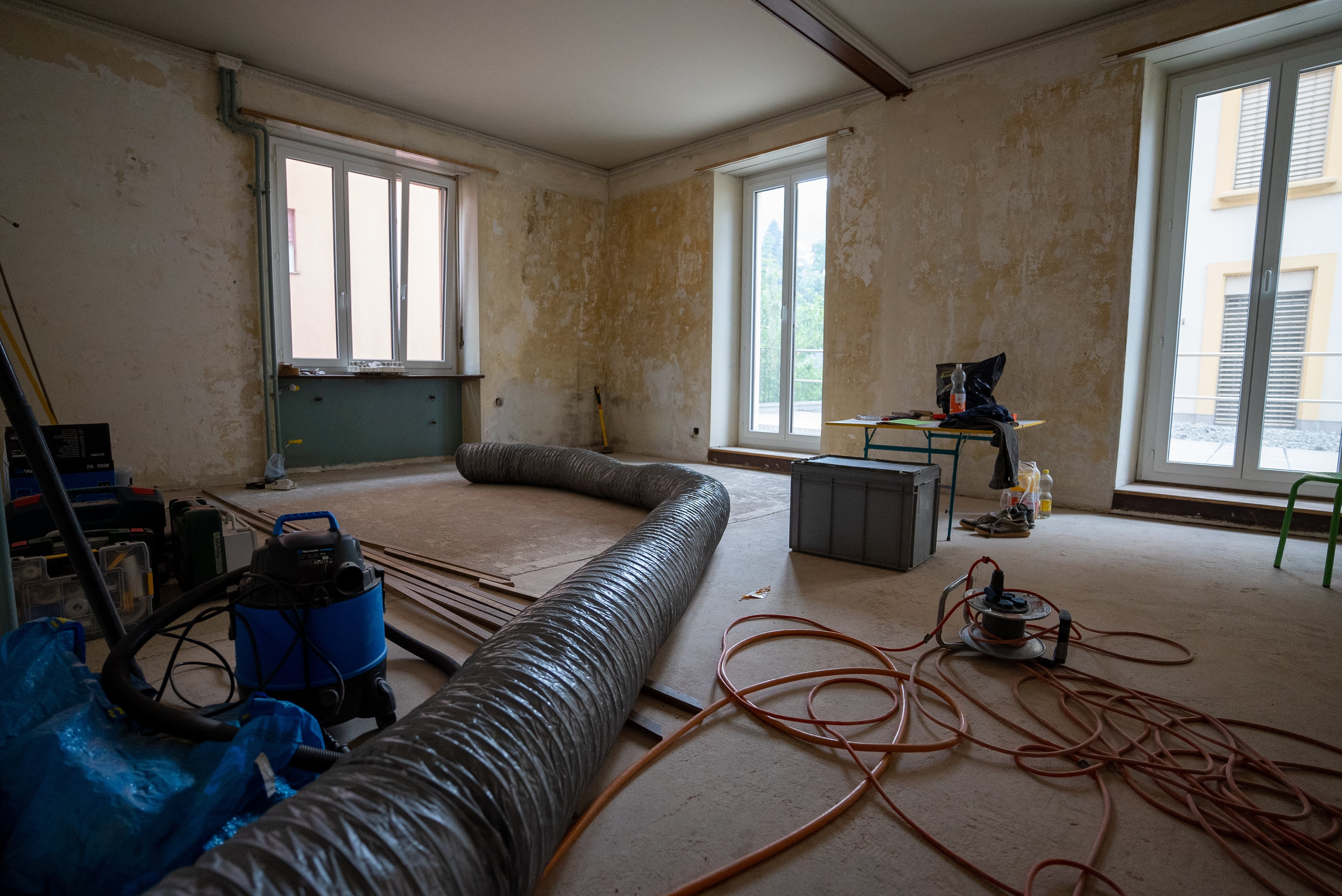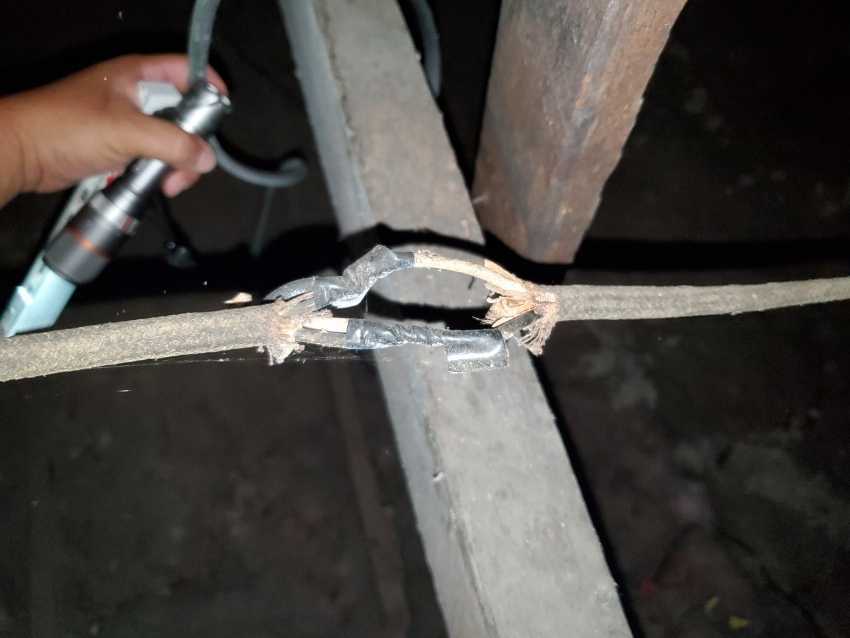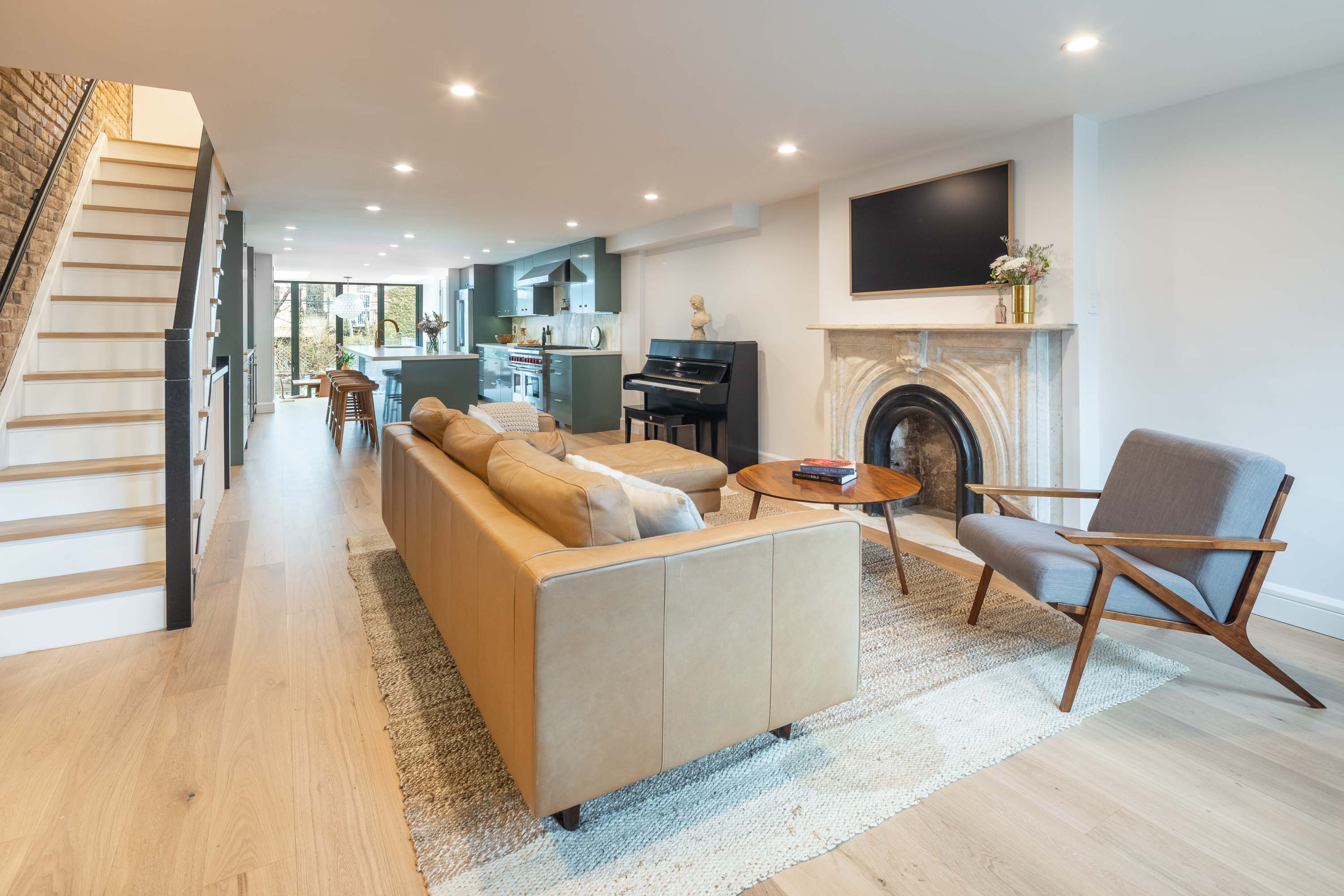Common Surprises When Renovating A NYC Apartment
Proper planning is the key to a successful renovation in NYC. Here's how to account for the three most common surprises found when renovating a NYC apartment.
April 12, 2024
|

Common Surprises When Renovating A NYC Apartment
How to plan for the three most common surprises found when renovating a NYC apartment, and identifying their impact on time and cost.
Table of contents
- Common NYC Renovation Surprise 1: Asbestos
- Common NYC Renovation Surprise 2: Cloth Wiring
- Common NYC Renovation Surprise 3: Insufficient Electrical Load
Here’s something that shouldn’t be a surprise - when a renovation isn’t planned properly the renovation will likely take longer and cost more, especially in New York. Yet, very often dream home renovations wind up in a nightmare thanks to various unexpected surprises that arise as a result of not doing proper due diligence up front in the always complicated process.
By understanding the implications of the following surprises that can arise when renovating a NYC apartment, anyone looking to remodel can get ahead of these potential project derailments and better manage their own expectations as an educated consumer.
If not properly planned for, there are quite a few potential issues that could surface during a renovation, but these three have the biggest impact on time and cost.
[#Asbestos]Common NYC Renovation Surprise 1: Asbestos[#Asbestos]

Asbestos is a mineral fiber known for heat resistance, durability, and insulating properties. That versatility led to widespread use in various industries, mainly construction, throughout the 20th century. As New York City experienced a boom during the 1950s, 60s, and 70s, asbestos became prevalent in many NYC builds.
Despite the productive properties and perceived benefits, asbestos has since been found to cause significant health risks to those exposed to its fibers. Prolonged inhalation or ingestion of asbestos can lead to serious health conditions, including lung cancer and mesothelioma.
These health risks resulted in regulations regarding asbestos use in the latter half of the 20th century. Eventually, laws were implemented around the world to limit asbestos exposure and use in construction materials phased out altogether.
These days, asbestos removal and abatement projects are conducted prior to renovations of older buildings to mitigate the risks posed by existing asbestos-containing materials, ensuring safe environments for occupants, workers and homeowners.
Identifying Asbestos in a NYC Apartment
If you’re buying a fixer-upper apartment in NYC and wondering if this hazardous material might be lurking, consider these common ways to identify asbestos in a NYC apartment:
Parquet Flooring
Original glued down parquet flooring in post war buildings built in the 50’s, 60’s and 70’s often contained asbestos.
Linoleum Tile
9” x 9” inch linoleum tile is a good indicator of asbestos in the glue used to install the tile, especially from the 50's to 70’s time period.
Estate-Conditioned Apartments
While less common, estate condition apartments often contain asbestos on the insulation of plumbing.
The Legal and Health Implications of Asbestos in Renovations
NYC enforces strict rules governing asbestos handling and removal during renovations. These guidelines, aimed at protecting workers and residents, require meticulous procedures for dealing with asbestos-laden materials. Compliance is essential at every stage of remediation, from identification to removal.
Engaging Licensed Professionals
Navigating NYC's asbestos regulations hinges on hiring licensed experts for testing and removal. Whether you’re hiring an asbestos abatement specialist or a design-build firm to handle the entire renovation, these professionals possess the necessary knowledge for accurate assessment. Licensed contractors ensure safe removal and disposal, adhering to regulations and safeguarding everyone involved.
Risks of DIY Asbestos Removal
DIY asbestos removal is a big no no. Disturbing asbestos can release dangerous fibers into the air, leading to unsuspecting health conditions that may not appear for years to come. Airborne asbestos fibers are typically agitated during common renovation tasks like drilling or sanding. While undisturbed asbestos presents minimal risk, any renovation work that disturbs the asbestos demands careful precaution to prevent exposure. Besides endangering personal health, DIY attempts can contaminate the renovation environment, putting others at risk.
Planning and Preparing for Asbestos Abatement

Renovations that disturb the asbestos-containing material cannot proceed until the asbestos is remediated by a company that specializes in asbestos removal. Still, just because a property contains asbestos does not necessarily mean the asbestos has to be removed or automatically poses a hazard to your health. Here are the ways to prepare for your property potentially having asbestos:
Asbestos Tests
At Gallery, we test for asbestos ahead of all renovations, so we can plan for the added effort or see if there's a way around the issue. By law, if you're doing work that disturbs the asbestos, mitigation is required and bringing in an asbestos remediation company for air quality removal and monitoring is likely in order. However if our preliminary tests confirm asbestos won’t be disturbed during the renovation, then we can plan to work around the area and avoid the issue altogether.
Speak To The Super
Prior to demo and during pre-planning, speak to the super and find out if other owners in the building have encountered asbestos. Some supers will be tight-lipped, especially to a prospective buyer, but asking doesn’t hurt and getting a heads up can save you time and potential re-scoping.
Determine Location
Sometimes asbestos can be found on plumbing. If branch plumbing, usually homeowners are responsible to mitigate or remediate. If asbestos is found on building plumbing (meaning, the risers), usually that's the building's responsibility. Thankfully, renovations don’t usually touch the risers, so having to remediate is less likely, since the asbestos won’t be disturbed. While not common, some NYC buildings ask the apartment owner to remediate asbestos on plumbing regardless whether it is found on the branch or the risers. In these circumstances it is useful to have a knowledgeable firm on your side that can guide your discussions with the building with respect to precedent of how other buildings typically operate.
Navigating Asbestos Remediation: Costs, Timelines, and Expectations
Embarking on asbestos remediation in NYC apartments warrants a clear understanding of the costs, timelines, and expectations. Below is what to anticipate during the remediation process, from expenses to project duration, plus how to manage expectations effectively.
Realistic View of Costs and Timelines
Asbestos removal projects can vary widely in terms of cost and duration, depending on several factors. Common asbestos removal projects typically range from $1,500 to $30,000, with larger-scale projects potentially exceeding this range. In rare instances, certain asbestos remediation requirements may be so significant they exceed the purchase price. Factors influencing costs include the extent of asbestos contamination, accessibility of affected areas, and the complexity of the remediation process.
Similarly, project timelines can vary from a few days to several weeks, depending on the size and scope of the project. Factors such as the need for specialized equipment, regulatory requirements, and the availability of licensed contractors can all impact the duration of asbestos remediation.
Tips for Budgeting and Managing Expectations
When budgeting and planning for asbestos remediation, consider these variables to plan accordingly:
Obtain Multiple Quotes
If you’re not working with a full-service renovation firm and overseeing the asbestos abatement on your own, make sure to get quotes from multiple licensed asbestos removal contractors to compare costs and services.
Factor in Contingencies
Budget for unexpected expenses or delays that may arise during the remediation process - especially if your renovation is a larger and more comprehensive project, with potential for more unwelcome surprises.
Plan for Disruption
Anticipate potential disruptions to your renovation project timeline and plan accordingly to minimize inconvenience. After all, you can’t live in a home during asbestos abatement.
[#Cloth]Common NYC Renovation Surprise 2: Cloth Wiring[#Cloth]

Cloth wiring was typically used in the late 1940's, 1950's and early 1960's. Having been there likely over half-a-century, the potential for problems is high. First, in renovation projects requiring electrical permits, cloth wiring will not pass inspection. Second, and more importantly, old cloth wiring freys over time and becomes increasingly more of a fire hazard when not replaced.
Signs You Have Might Have Cloth Wiring
Here is the key indicator a home may have cloth wiring behind the walls:
Pre-War Space
Pre War buildings and apartments built during the 50’ through 70’s were wired with cloth wire. Many of these apartments have since been upgraded but unless a previous renovation involved rewiring of the space then it is safe to assume the original cloth wiring still exists).
How To Account For Finding Cloth Wiring
If renovating an apartment in NYC, here are the factors to consider if a home ends up having cloth wiring:
Electrical Tests
At Gallery, we test the electrical wiring prior to any renovation in order to determine if there will be any implications on our project scope.
Replace The Wiring
The moment cloth wiring is identified upon inspection the best practices strongly recommend rewiring and replacing the outdated wiring with a more modern metal-armored or plastic-sheathed alternative.
Consider Cost & Time To Replace
The cost of any specific line item on a renovation task list is relative to the entire size of the project. When considering rewiring though, the work is both time-consuming and costly. Rewiring a typically 3 bedroom apartment in NYC will cost roughly $30-50k on average and 4-6 weeks total time to accommodate. This process typically requires the following steps:
- Step 1) Creating the path to ensure electrical is in the best place possible for design
- Step 2) Channeling the Wiring
- Step 3) Running the Wiring
- Step 4) Plastering the Walls
- Step 5) Skim Coat the Walls (usually advisable but not in all circumstances)

[#Load]Common NYC Renovation Surprise 3: Insufficient Electrical Load[#Load]
Having an insufficient electrical load is an easy issue to leave unaccounted for, but one that often results in big problems when taken for granted. In NYC there is a certain circuit breaker load limit per building (divided up by each individual apartment), which cannot be exceeded. If exceeded, buildings have electrical shortages and potentially full power outages.
Signs You Might Have An Insufficient Electrical Load
Here are key indicators your home or apartment may have an insufficient electrical load:
Flickering Lights
An exhausted electrical panel will affect your home in various ways, but flickering lights may be the most obvious. Lights flicker because they’re not getting their proper share of the electrical breaker. If plugging in more items makes the flickering worse, there’s almost certainly an insufficient electrical load.
Breakers Trip Often
Breakers cut the electricity when the circuit shorts or overloads. If this happens often in a building, there’s a good chance there’s not much wiggle room in the breaker load.
Current Appliances Can’t Keep Up
If there are already issues running high-end appliances, trying to add more upon a renovation will only put more pressure on the breaker.
Penthouse Renovation
In older NYC pre-war buildings, penthouses that haven’t been renovated in a while may struggle to meet modern electrical demands. This is often due to outdated electrical systems, and the fact that being higher up in the building can make it more challenging for power to effectively reach the top floors.
- Expanded Reading: 6 Key Considerations When Planning A Penthouse Renovation In Manhattan
How To Account For An Insufficient Electrical Load

Considering an apartment renovation in NYC? Here's how to deal with an insufficient electrical load:
Electrical Tests
At Gallery, we test current and proposed electrical loads prior to any renovation in order to determine if we’ll need to adjust our clients’ appliance selections accordingly or if an electrical service upgrade will be required.
Power Up
Upgrade the amount of power coming into the apartment, which can be very costly depending on the conditions of the building.
Reconsider Your Appliances
Although not ideal, choosing different appliances with less electrical requirements is likely the more practical approach to fixing electrical load issues.
- Expanded Reading: The Essential Guide to Electrical Updates in NYC Apartment Renovations
[#Benefits]Benefits Of Preparing For Common Surprises When Renovating A NYC Apartment[#Benefits]
Here are the key benefits of preparing for common surprises when renovating a New York City apartment:
Safety First
Over time, cloth wiring frays and becomes more susceptible to fire damage. As electrical loads are added over time, the wires become even more volatile. Updating cloth wiring provides safe surroundings and long-term peace of mind. Proactiveness with asbestos removal is essential as well, reducing the potential to become disturbed over time and pollute the home air quality.
Electric-Centric NYC
In recent years, New York City has been enforcing stronger regulations on gas and electric. As the city looks to move away from gas towards electricity, NYC has become more diligent about ensuring old electrical components are redrawn.
How Gallery Helps Our Clients Avoid Surprises When Renovating A NYC Apartment
There is no substitute to proper planning and the same is true of testing for the potential conditions that can derail a renovation project should they be uncovered too late. Early in the planning process we test for numerous factors like asbestos, electrical loads, and hidden structural, plumbing, and electrical elements. Based on the findings, we give clients their site conditions and options, then propose the costs for all potential routes. Like planning, there is also no substitute for experience - at Gallery we pride ourselves in our deep knowledge of renovating in NYC buildings and the creativity we bring to problem solving the unique challenges.
Ready to renovate with experienced design-build contractors in NYC? Explore more of our work, or contact us to see why our New York City apartment renovation and remodeling services are the most mindful choice when considering a residential renovation in Manhattan or Brooklyn.

.png)
.png)


-min.JPG)


.jpg)

%20(2).jpg)


.jpg)
%20Gallery%20KBNY.JPG)


